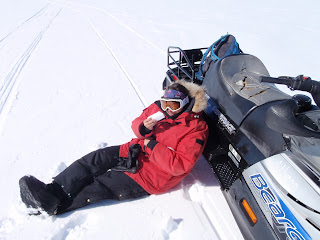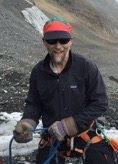Today was another day of acclimatization, and getting ready for the work at hand. While our GPS station continued to log away at our first site, getting better and better measurements with increased occupation time, we spent our time in training and planning.
First, snowmobile training. While I've been riding snowmobiles on ice sheets for almost 20 years now, there are always subtle differences with the machines from season to season, and getting the rundown on the machines from the mechanic responsible for their upkeep is always a valuable thing. Also, not everyone has ridden a snowmobile before!
Joanna about to take her first snowmobile ride!
In addition to this, we spent a lot of time planning out where we plan to go (visiting the stakes that are arrayed around the station at distances of 3 to 36 km), so that the station crew here has our "flight plan" to which they can refer if we fail to check in on time. Here's an excerpt from our plan:
** Full day plan 1:
- depart summit 08:30
- arrive C3N 08:45, begin 15 min occupation
- depart C3N for C6N 09:10
- arrive C6N 09:25, begin 15 min occupation
- depart C6N 09:50 for FL3W
- arrive FL3W 10:20, begin 15 min occupation
- depart FL3W for FL6W 10:35
- arrive FL6W 10:50, begin 15 min occupation
- depart FL6W for FL9W 11:10
- arrive FL9W 11:25, begin 20 minute occupation
- depart FL9W for W6S 11:50
- arrive W6S 12:20, begin 25 min occupation
- depart W6S for W3S 12:55
- arrive W3S 13:10, begin 25 min occupation
- depart W3S for W0N 13:45
- arrive W0N 14:00, begin 25 min occupation
- depart W0N for W3N 14:35
- arrive W3N 14:50, begin 25 min occupation
- depart W3N for W6N 15:25
- arrive W6N 15:40, begin 25 min occupation
- depart W6N for Summit 16:15
- arrive Summit 17:45
Now, it doesn't always go exactly according to our planned times, but it's important to have some estimates to see if what you plan is reasonable! With luck tomorrow will be our first survey day...


















